|
Report
from
North America
Furniture manufacturing remains fastest growing
industry
Economic activity in the US manufacturing sector
expanded for the second consecutive month in July,
according to the Institute of Supply Management.
The overall economy expanded for the 50th consecutive
month. The fastest growing industry sector was again
furniture and related products. Wood product
manufacturers also reported growth.
US unemployment was 7.4% in July, down from 7.6% in
June, according to the US Bureau of Labor Statistics.
Consumers expect interest rate rise
Consumer confidence in the US economy remained strong
in July, according to the Thomson Reuters/University of
Michigan consumer sentiment index. More consumers
(68%) expect interest rates to rise.
A rise in interest rates dampens the longer term economic
outlook, but more consumers plan big purchases ahead of
higher interest rates.
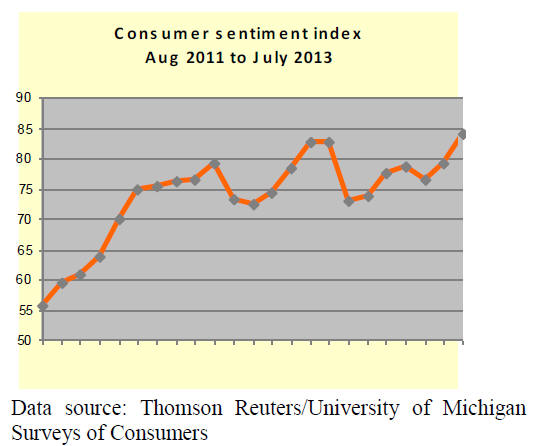
Home builders¡¯ confidence highest in Midwest and
West
Builder confidence in the market for newly built singlefamily
homes was at its highest since January 2006. The
National Association of Home Builders reports a 6 point
increase in July in the Home Builders/Wells Fargo
Housing Market Index, following an 8 point increase in
June. This is despite a relatively slow recovery in housing
starts.
Builders. confidence was highest in the US Midwest,
followed by the West and South. Home builders in the
Northeast were the least confident in the market.
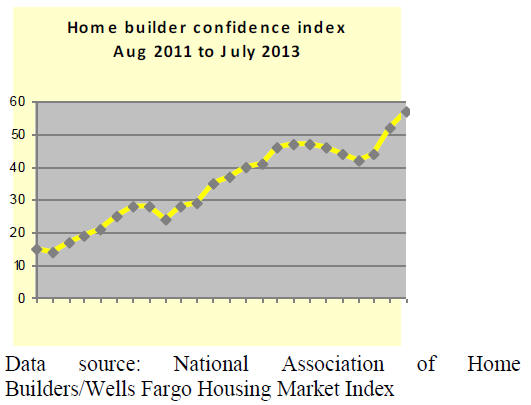
Multi-family construction down, single-family
unchanged
US housing starts declined by 9.9% in June to 836,000 at a
seasonally adjusted annual rate. The decline was primarily
in multi-family construction, which is more volatile in the
US market than single-family home building. Singlefamily
starts remained stable from the previous month.
Housing starts declined in all four regions: US West (-
5.4%), Midwest (-7.4%), South (-12%) and Northeast (-
12.1%).
The number of building permits issued declined by 7.5%
to 911,000 in June at a seasonally adjusted annual rate.
Permits for multi-family housing fell by 21.4%. Singlefamily
permits grew only slightly (+0.6%). The number of
permits issued is usually an indicator of future building
activity.
Existing home sales down, prices up
Sales of existing homes also declined from May to June.
Sales fell by 1.2% in June at a seasonally adjusted annual
rate, according to the National Association of Realtors.
The national median price for existing homes sold was
$214,200, 13.5% higher than in June 2012.
Mortgage rates rose to over 4% in June. Further mortgage
rate increases are expected to moderate the housing market
in expensive areas such as California, Hawaii and New
York City.
Canadian housing starts decline
Canada‟s housing starts declined by 2.5% in June,
according to the Canada Housing and Mortgage
Corporation. Construction started on 200,000 units at a
seasonally adjusted annual rate. Both multi-family and
single-family starts declined. Sales of existing homes grew
by 3.3% in June, at a seasonally adjusted rate. The average
home price was C$386,585 in June, up 4.8% from June
2012.
Canada‟s central bank announced in July that the target
interest rate would remain unchanged at 1%. Mortgage
rates have been steady at around 5% since June 2012.
Non-residential construction unchanged
Spending in non-residential construction in June was
virtually unchanged from the previous month, at a
seasonally adjusted rate. However, April and May
spending have been revised upwards.

Architectural firms also reported only a modest
improvement in business conditions in June. According to
the Architecture Billings Index, firms in the US Northeast
and the South perform better than in the Midwest and
West.
Hardwood plywood imports
US hardwood plywood imports remained at low levels in
June. The drop in imports from China due to the US antidumping
and countervailing investigation has not been
offset by other suppliers, although Indonesia has
significantly increased plywood shipments to the US.
US imports of hardwood plywood declined by 7% from
May to June. Total imports were 200,248 m³ in June with
one third (65,377 m³) imported from China. By
comparison, two thirds of total 2012 US hardwood
plywood imports came from China.
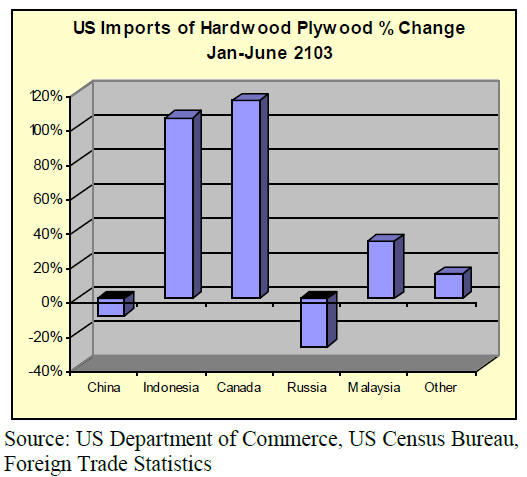
Other major suppliers to the US market have markedly
increased hardwood plywood shipments in 2013, with the
exception of Russia. Indonesia shipped 60,315 m³ in June,
up 133% from May. Year-to-date imports from Indonesia
more than doubled.
Hardwood moulding imports
Hardwood moulding imports declined by 8% to $16.1
million in June (-6% year-to-date). Hardwood moulding
imports from both China and Brazil declined. Imports
from China were $4.8 million in June (-9% year-to-date),
while $4.7 million worth were imported from Brazil (-17%
year-to-date).
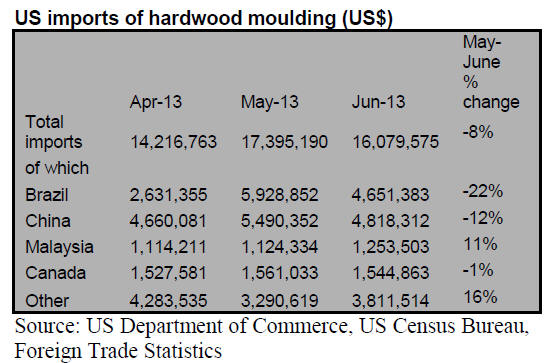
Wood flooring imports
US imports of assembled flooring panels increased to
$11.0 million in June. Year-to-date imports are still 6%
lower than in 2012.
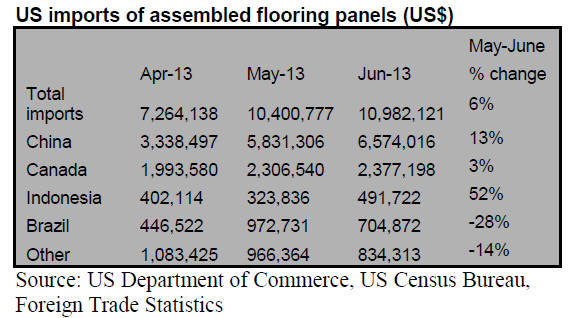
China.s shipments accounted for 60% of total assembled
flooring imports in June. On a year-to-date basis, imports
from China declined by 20%, while imports from
Indonesia increased by 12%.
Hardwood flooring imports were $2.3 million in June,
down 22% from May. Indonesia has become the leading
supplier to the US so far in 2013. In June imports from
Indonesia were $1.0 million (+86% year-to-date).
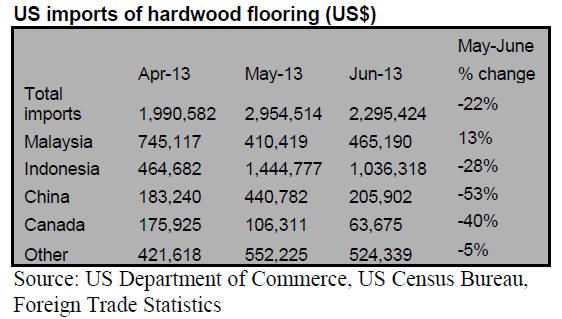
Wooden furniture imports
The US imported $1.2 billion worth of wooden furniture
in June, slightly up from the previous month. Year-to-date
imports were 3% higher than in June 2012.
China‟s furniture shipments to the US were $591.1 million
in June (+1% year-to-date). Imports from Vietnam
recovered to $172.5 million (-11% year-to-date), after
appearing to drop sharply in May. The May data for US
imports from Vietnam is suspiciously and therefore
probably erroneous.

Furniture and flooring retail sales positive
Retail sales at furniture stores in the US increased by 6%
from April to May, according to US Census Bureau
figures. However, furniture sales were 4% lower than in
May 2012.
Retail sales at floor covering stores grew by 10% in May
from the previous month. Flooring sales were higher
(+4%) than in May last year. These sales figures include
both wood and non-wood flooring products.
Home remodelling spending on the rise
With rising home prices and sales, US homeowners spend
more on home improvement projects. New homeowners
are the most likely to carry out major home improvements.
Flooring replacement is the most common remodelling
project, following by replacing kitchen and bathroom
cabinets.
Spending on home remodeling has steadily increased since
the end of 2012, according to US Census Bureau data.
Spending in the first quarter of 2013 reached $127 billion.
Remodelling contractors were confident in the market in
the second quarter of 2013, according to the Remodelling
Market Index survey by the National Association of Home
Builders. For the first time in eight years, contractors
reported a consistently positive outlook.
The Joint Center for Housing Studies at Harvard
University projects a further improvement in the
remodelling market for the second half of 2013.
Strengthening sales of existing homes in particular raise
spending on remodelling. For the last quarter of 2013
spending on remodelling is projected to surpass $150
billion.
Countertop market study released
A new market study released by Freedonia in July
describes the US market for countertops and forecasts
demand through 2017 and 2022 (Freedonia Study #3049).
Countertops are primarily used in residential kitchens and
bathrooms. In 2012, 79% of countertop demand was in the
residential market, mainly in single-family homes.
Therefore, single-family housing starts is the most
important driver of countertop demand.
US countertop demand was 582 million square feet (54
million m2) in 2012. Freedonia forecasts that demand will
increase by 5.1% per year to 750 million square feet (70
million m2) in 2017.
The recovery of new home construction will boost demand
for countertops through 2017. Remodeling of older homes
will also support market growth.
The leading countertop material is laminate, usually on
composite wood. The share of laminates in total demand
has declined from 60% ten years ago to about half in 2012,
and this trend is forecast to continue. Natural stone and
engineered stone have become more affordable, replacing
laminate countertops.
|